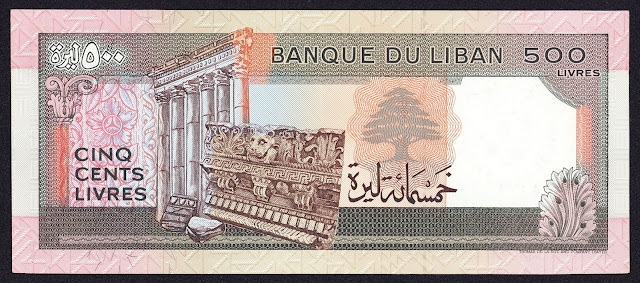Currency of Lebanon 500 Livres banknote 1988
Bank of Lebanon - Banque du Liban
Lebanon Banknotes - Lebanon Paper Money
Obverse: Costal view of Beirut. Denomination is in Arabic numeral.
Reverse: Columns of the Temple of Jupiter at left and Cornice block with a lion head as water spout, a detached part of the cornice at the Temple of Jupiter in ancient city of Baalbek. Denomination in words is in French language.
Main colors: Brown and olive-green on multicolored underprint.
Watermark: Lion's head.
Dimensions: 156 x 67 mm.
Printer: Thomas De La Rue & Company Limited, London, England.
The above Banknote denomination is being withdrawn from circulation and can be exchanged at the Banque du Liban main branch until 31st of July, 2014.
Lebanon Banknotes - Lebanon Paper Money
1964 - 1993 Issues
On 1 August 1963 decree No. 13.513 of the “Law of References: Banque Du Liban 23 Money and Credit” granted the Bank of Lebanon the sole right to issue notes in denominations of 1, 5, 10, 25, 50, 100, and 250 pounds, expressed in Arabic on the front, and French (livres) on the back. All of these notes have security fibers embedded in the paper, though the location of them varies from right to left, and front to back, on different denominations.Beirut
Beirut (French: Beyrouth) is the capital and largest city of Lebanon. No recent population census has been done but in 2007 estimates ranged from slightly more than 1 million to slightly less than 2 million as part of Greater Beirut. Located on a peninsula at the midpoint of Lebanon's Mediterranean coast, Beirut is the country's largest and main seaport.
It is one of the oldest cities in the world, inhabited more than 5000 years ago. The first historical mention of Beirut is found in the ancient Egyptian Tell el Amarna letters dating from the 15th century BC. The Beirut River runs south to north on the eastern edge of the city.
Beirut is Lebanon's seat of government and plays a central role in the Lebanese economy, with most banks and corporations based in its Central District, Badaro, Rue Verdun, Hamra and Ashrafieh. Following the destructive Lebanese Civil War, Beirut's cultural landscape underwent major reconstruction. Identified and graded for accountancy, advertising, banking/finance and law, Beirut is ranked as a Beta World City by the Globalization and World Cities Research Network.
In May 2015, Beirut was officially recognized as one of the New 7 Wonders Cities together with Vigan, Doha, Durban, Havana, Kuala Lumpur, and La Paz.

